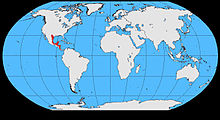- Brown Jay
-
Brown Jay Adult bird.
Camelia Roja, San Juan Bautista Tuxtepec, OaxacaConservation status Scientific classification Kingdom: Animalia Phylum: Chordata Class: Aves Order: Passeriformes Family: Corvidae Genus: Psilorhinus Species: P. morio Binomial name Psilorhinus morio
Wagler, 1829
Range (click to magnify) The Brown Jay (Psilorhinus morio) is a large American Jay which has the habitus of a magpie, but is slightly smaller and with a shorter tail, though the bill is larger.
It occurs from Mexico south into Central America on the Gulf slope. The northernmost extent of the bird is on the Rio Grande in southern Texas, the lower region of the river called the Rio Grande Valley, (of Texas).
Description
Brown Jays vary in plumage geographically: there are two main groups. Northern birds are almost completely dark brown, with lighter brown on the underparts. Southern birds are white-bellied and have bright white tips to the outer tailfeathers. The intergrade zone is in Veracruz.
Adults in both populations have black bills, legs, and feet. Immatures have yellow bare parts, including yellow eye-rings.
The voice is a loud but low pitched pee-ah call and is often modified to suit its situation or mood.
Ecology
Food is sought largely in trees but it also takes some food from the ground. Insects and a wide range of other invertebrates are taken, also lizards, fruit,[1] and nectar. Though it does take eggs and nestlings, it appears not to if there is plenty of other foods available.
The nest is built in a tree or large shrub with both sexes helping in construction. There are normally three eggs laid but six is not unusual. Incubation is between 18 and 20 days. Only the female broods but the father feeds her while doing so.
Sometimes the young from another year will help in raising the chicks too. If a helper bird returns with food, it will give it to one of the resident parents to feed the chicks.
Range
In Central America the Brown Jay is not found in El Salvador; the range also appears on the Pacific side of Central America in Nicaragua, Costa Rica, and western Panama.
Footnotes
- ^ E.g. of Trophis racemosa (Moraceae), though they are rather indiscriminating feeders (Foster 2007).
References
- BirdLife International (2004). Cyanocorax morio. 2006. IUCN Red List of Threatened Species. IUCN 2006. www.iucnredlist.org. Retrieved on 12 May 2006. Database entry includes justification for why this species is of least concern
- Foster, Mercedes S. (2007): The potential of fruiting trees to enhance converted habitats for migrating birds in southern Mexico. Bird Conservation International 17(1): 45-61. doi:10.1017/S0959270906000554 PDF fulltext
External links
- Juvenile bird with yellow bill
- VIREO: Brown Jay photo gallery
- Internet Bird Collection: Brown Jay videos
- Photo-High Res - greglasley.net
- Photoe-High Res; Article - otterside.com–"Crow/Jay Image page"
Extant species of family Corvidae Kingdom: Animalia · Phylum: Chordata · Class: Aves · Subclass: Neornithes · Superorder: Neognathae · Order: PasseriformesFamily Corvidae Choughs Treepies PlatysmurusTemnurusOriental
magpiesOld World jays PtilostomusStresemann's
BushcrowZavattariornis
Categories:- IUCN Red List least concern species
- Cyanocorax
- Birds of Mexico
- Native birds of Eastern Mexico
- Birds of the U.S. Rio Grande Valleys
- Birds of the United States
- Native birds of Southern Mexico
- Birds of Central America
- Birds of the Yucatán Peninsula region
- Birds of Belize
- Birds of Guatemala
- Birds of Honduras
- Birds of Nicaragua
- Birds of Costa Rica
- Birds of Panama
Wikimedia Foundation. 2010.
Look at other dictionaries:
brown jay — rudieji kėkštai statusas T sritis zoologija | vardynas atitikmenys: lot. Psilorhinus angl. brown jay vok. Braunhäher, m rus. бурая сойка, f pranc. geai enfumé, m ryšiai: platesnis terminas – varniniai siauresnis terminas – rudasis kėkštas … Paukščių pavadinimų žodynas
brown jay — rudasis kėkštas statusas T sritis zoologija | vardynas atitikmenys: lot. Psilorhinus morio angl. brown jay vok. Braunhäher, m rus. бурая сойка, f pranc. geai enfumé, m ryšiai: platesnis terminas – rudieji kėkštai … Paukščių pavadinimų žodynas
Brown-necked Raven — Conservation status Least Concern ( … Wikipedia
Brown-headed Crow — Conservation status Near Threatened (IUCN 3.1) Scientific classification Ki … Wikipedia
Jay Brannan — en concierto en el Crawdaddy (Dublín) en 2008. Jay Brannan (29 de marzo de 1982) es un actor y cantautor estadounidense nacido en Houston. Jay, que es abiertamente homosexual, consiguió su reconocimiento internacional con su participación en… … Wikipedia Español
Jay — Taxobox name = Jays image width = 200px image caption = Blue Jay regnum = Animalia phylum = Chordata classis = Aves ordo = Passeriformes familia = Corvidae subdivision ranks = Genera subdivision = * Garrulus * Podoces * Ptilostomus * Perisoreus * … Wikipedia
Jay Brannan — Infobox actor name = Jay Brannan caption = birthname = Jay Brannan birthdate = birth date and age|1982|3|29 birthplace = Houston, Texas othername = occupation = Singer songwriter, actor yearsactive = 2006 Current spouse = website =… … Wikipedia
Jay-Z — en Fort Lauderdale, Florida en 2008. Datos generales Nombre real Shawn Corey Carter Nacimiento … Wikipedia Español
Jay Dardenne — Dardenne (at left) 58th Lieutenant Governor of Louisiana Incumbent Assumed office November 22, 2010 Governor … Wikipedia
Jay Chou — Chou on the red carpet at the MTV Asia Aid, Bangkok, Thailand, 2005 Chinese name 周杰 … Wikipedia


